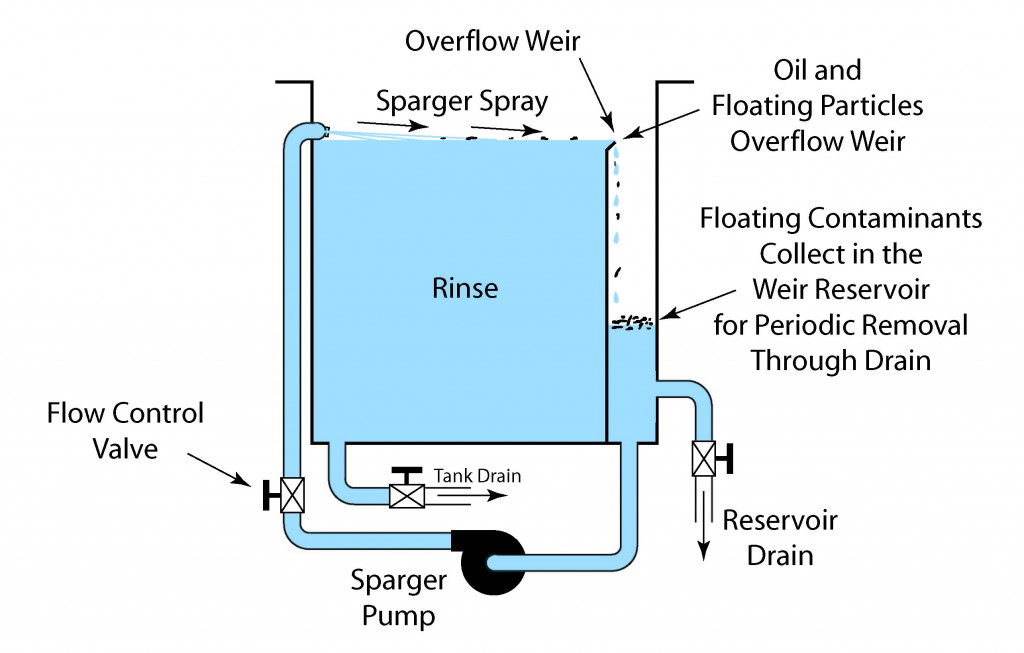Providing the best and most efficient rinse in an aqueous cleaning process requires maintaining the cleanest possible water in the rinse. In spray rinses, this can be accomplished by using fresh water for the spray. A spray rinse with fresh water, although effective, is often not practical. Using a constant supply of fresh water is costly, especially if it needs to be heated prior to use.
One of the options to a fresh water spray rinse is an immersion rinse where cleaned parts are dipped into a rinse bath following cleaning. One of the challenges in immersion rinsing is controlling buildups of particles and oil which are inevitably carried over from the preceeding washing process. This is accomplished using filters and skimmers in the rinse tank.
Particles that are heavier than water (metal chips, casting sand and fractured pieces of vibratory finishing media for example) usually sink to the bottom of a rinse tank. Particles lighter than water (bits of plastic, styrofoam, wood, etc.) float to the surface. In some cases, particles that are heavier than water are given buoyancy by clinging air bubbles in which case they, too, can float to the surface although they are, in fact, heavier than water. Extremely small particles and those with neutral buoyancy may remain suspended in the liquid indefinitely. Suspension of small particles is promoted by turbulation of the rinse tank caused by the entry and exit of parts and other influences.
Filtration –
Particles that are heavier than water or remain in suspension are captured using filters. Liquid exits the tank to a pump and is forced through a filter which removes particles prior to its being returned to the tank. For most efficient operation of a pump and filter, the outlet from the tank should be located either on the bottom of the tank or on a side near the bottom. Locating the return of filtered liquid near the top of the tank and removed as far as possible from the outlet helps increase the efficiency of filtration. For more detail on how filters are applied and their efficiency, see the blog Sorting Out Filters – About Re-Circulation.
Overflow Weir –
Floating contaminants include oil and many lighter than water solids examples of which are mentioned above. Filters are relatively ineffective in removing these floating contaminants. The risk of allowing floating contaminants to remain on the surface of the liquid is that they may be re-deposited on parts as the parts exit the rinse tank. Fortunately, floating contaminants can often be successfully removed using an overflow weir as shown in the following illustration.

The ability of a weir to remove floating contaminants can be enhanced by using a device (often called a “sparger”) to encourage them to cascade over the lip of the weir.
Note – As so often happens when I research information to assure accuracy of this blog, I have learned that the word “sparger” is one that has been adopted, perhaps incorrectly, by the cleaning community. Sparging is actually a process in which oxygen or another gas is bubbled through molten metal to clean and affect the properties of the metal. A secondary meaning is a “sprinkle” which, I guess, is the connection to the cleaning process. We generally, however, think of a flow of liquid that is a little more aggressive than a “sprinkle” when we are discussing “spargers” in the context of this blog.
“Sparging,” although most frequently accomplished using a liquid, can also utilize air or another gas to help sweep the liquid surface of floating contaminants. Air spargers are useful when there is a need to clear the surface of a tank that does not have a weir. In effect, the air blows floating contaminants to one side of the surface of the tank leaving a cleared area through which parts can exit. Frequent removal of collected floating contaminants is required for an air sparger to remain effective as floating contaminants are displaced but not removed.
There are many more features of filters and spargers in addition to those discussed above which must be considered in the specification and application of an effective rinse. These and more will be discussed in upcoming blogs.
– FJF –



 English
English Spanish
Spanish Chinese
Chinese Canada
Canada Mexico
Mexico United Kingdom
United Kingdom



